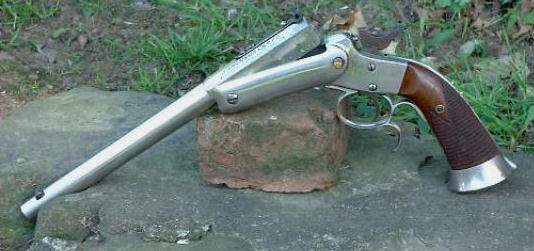

 The Accurate Reloading Forums
The Accurate Reloading Forums  THE ACCURATE RELOADING.COM FORUMS
THE ACCURATE RELOADING.COM FORUMS  Guns, Politics, Gunsmithing & Reloading
Guns, Politics, Gunsmithing & Reloading  Single Shot Pistols
Single Shot Pistols  Twist rate a function of weight or projie lnth?
Twist rate a function of weight or projie lnth?Go  | New  | Find  | Notify  | Tools  | Reply  |  |
| one of us |
Is the required twist more effected by bullet weight or length? for instance, if we compare a 22-250 and a 223, would both at a 12in. twist stabilize a 70 gr. bullet even though the velocitys involved are very different? Also if the bullet in either was showing signs of not being stabilized would I have to increase or decrease velocity to improve the stabilization? Rick | ||
|
one of us |
Cricker I just did a search on this subject & found an article about Twist rate & speed. It looks ok from scanning it quickly. I don't know how good or knowledgeable this person is but, it might be worth looking at. Rich Jake http://www.mamut.com/homepages/Norway/3/15/MarkBrooks/newsdet37.htm | |||
|
| one of us |
The required twist rate is directly affected by the length of a bullet, but since weight has a great determination of the length of a bullet for a given caliber I guess you could say that both have a pretty direct impact on the required twist rate. Another couple of things to consider is the "form" or shape of the bullet and the amount of surface that contacts the lands generally affects how well a bullet is stabilized. | |||
|
| one of us |
cricker, The twist rate required to stabilize a bullet can be determined with the Greenhill Formula. It is a turn-of-the-century formula developed based on solid bullet behavior. It works for today's bullets, but some adjustment are needed for the plastic tip bullets. Most adjustments can be made through the constant in the formula. Rather than to try to describe the formula here where mathematical language doesn't work, I'd suggest you do a search with "Greenhill Formula", you will find more information than you care to have. Don Shearer | |||
|
| Powered by Social Strata |
| Please Wait. Your request is being processed... |
|
 The Accurate Reloading Forums
The Accurate Reloading Forums  THE ACCURATE RELOADING.COM FORUMS
THE ACCURATE RELOADING.COM FORUMS  Guns, Politics, Gunsmithing & Reloading
Guns, Politics, Gunsmithing & Reloading  Single Shot Pistols
Single Shot Pistols  Twist rate a function of weight or projie lnth?
Twist rate a function of weight or projie lnth?

Visit our on-line store for AR Memorabilia

